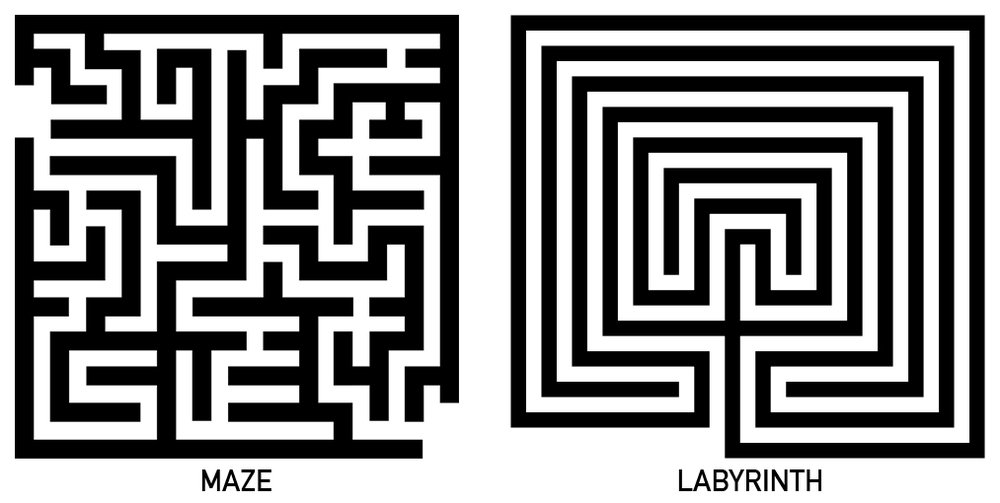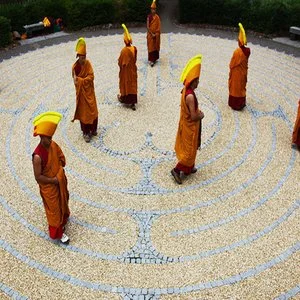WHAT IS LABYRINTH?
A labyrinth is an age-old path of relaxation, inspiration, and wisdom. It has been found in cultures ranging from India to North America to Europe with a history dating back over 3000 years. It is a meditative tool that induces a contemplative, intuitive state. Typically labyrinths have a single circuitous path that winds its way into the center and out again. A labyrinth is not a maze. It has no dead ends. Mazes are complex and require left-brain thinking and logic. Mazes challenge, labyrinths invite.
The single path ensures you cannot get lost. Their numerous 180° turns to shift your awareness from right brain to left brain. These shifts balance the two hemispheres of the brain resulting in a meditative state linked to physical and emotional healing.
Labyrinths appear periodically throughout history at times of great change and spiritual crisis. They serve as a kind of gyroscope, steadying and balancing us, reordering our priorities, rescuing us from the past and the future to experience the power of the present moment. The last resurgence of labyrinths was during the medieval period. The most famous example is located at Chartres in France, built in 1201 ad.
BENEFITS
There are many reasons to choose to walk a labyrinth – to celebrate, to grieve, to slow down, to seek insights and inspiration, to find stillness and compassion or sheer curiosity. Whatever the reason or occasion, walkers report the following afterwards:
Experiencing tranquility and peace
Reducing stress and irritation
Re-establishing equilibrium and balance
Increasing intuition and insight
Enhancing physical and emotional healing
Experiencing happiness and sometimes tears
Reduced grief, enhanced physical and emotional healing
Developing creativity and awareness
Generating a sense of community with others
Because reaching the center is assured, walking the labyrinth is more about the journey than the destination, about being rather than doing, integrating body and mind, psyche and spirit into one harmonious whole.
Since 1991 labyrinths have seen a resurgence in popularity in the west largely led largely by
Dr. Lauren Artress. Communities, schools, hospitals and communities are all building them.
Research conducted by Dr. H. Benson at Harvard Medical School’s Mind Body Medical Institute has found that focused walking meditations are highly effective at reducing anxiety and eliciting the relaxation response - ‘labyrinth effect’.
Regularly eliciting this response results in:
Lowering blood pressure
Lowering breathing rates
Reducing incidents of chronic pain
Reducing insomnia and
Improving fertility
It is said the labyrinth will meet us where we are to give us what we need.
“Walking is a man’s best medicine.”
- Hippocrates
WHO USES THEM?
Churches & other religious institutions
Builds community
Offers a spiritual practice of walking prayer and meditation.
Schools
Decreases disciplinary interventions
Calms and focuses children suffering from ADHD
Stimulates idea generation and creativity
“Walking would teach people the quality that youngsters find so hard to learn - patience.”
- Edward P. Weston
Communities
Unites people with a common purpose
Hospitals
Focuses attention ie doctors prior to surgery
Offers relief for grieving and a space for contemplation and centering
Companies
Team building
Foster creativity
Reduce stress
“Me thinks that the moment my legs begin to move, my thoughts begin to flow.”
- Thoreau
WHAT TO EXPECT?
Whether the goal is to decrease stress, or to inspire creativity, to manage conflict and change, or to have a change of pace, the labyrinth offers a meaningful metaphor for many day to day issues. Depending on your desired outcomes your labyrinth experience will be tailored to your needs.
Partial list of offerings:
Team buildings, idea generation, conflict management stress reduction
Rituals, celebrations and ceremonies
Community events
Building of permanent and temporary labyrinths
Location:
Indoors or outside
Time:
A labyrinth experience may be incorporated into a longer-term training program as a tool for reflection, to integrate learnings, or as a metaphor for dealing with conflict or change. Alternatively, the labyrinth can be used as a tool for centering and meditation.
time required depends on the size of the group and the width of the space.
Martha Collard is the Asia Representative for The Labyrinth Society, is a Veriditas Certified Labyrinth Builder and Facilitator.







